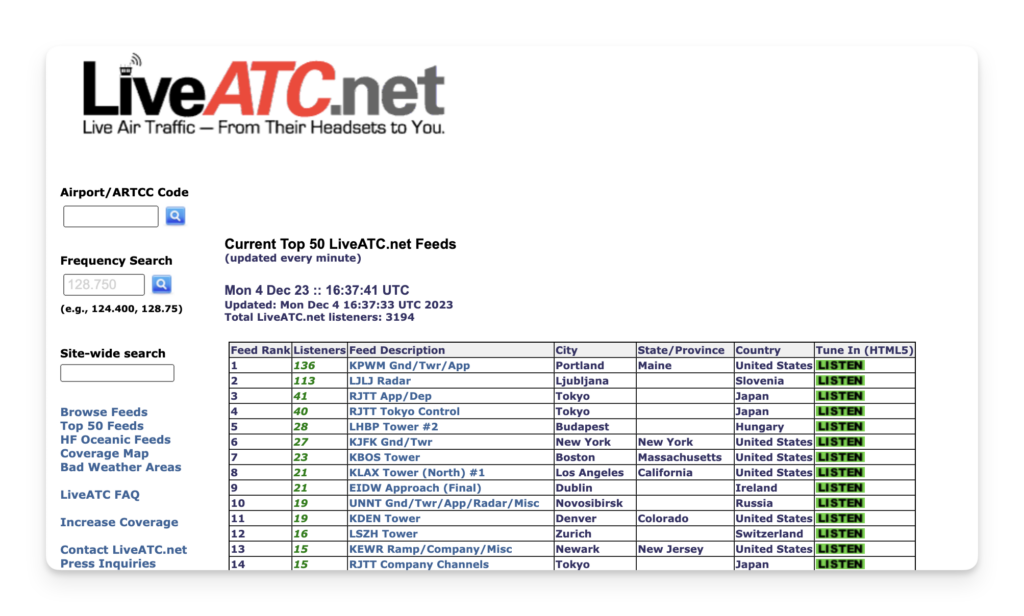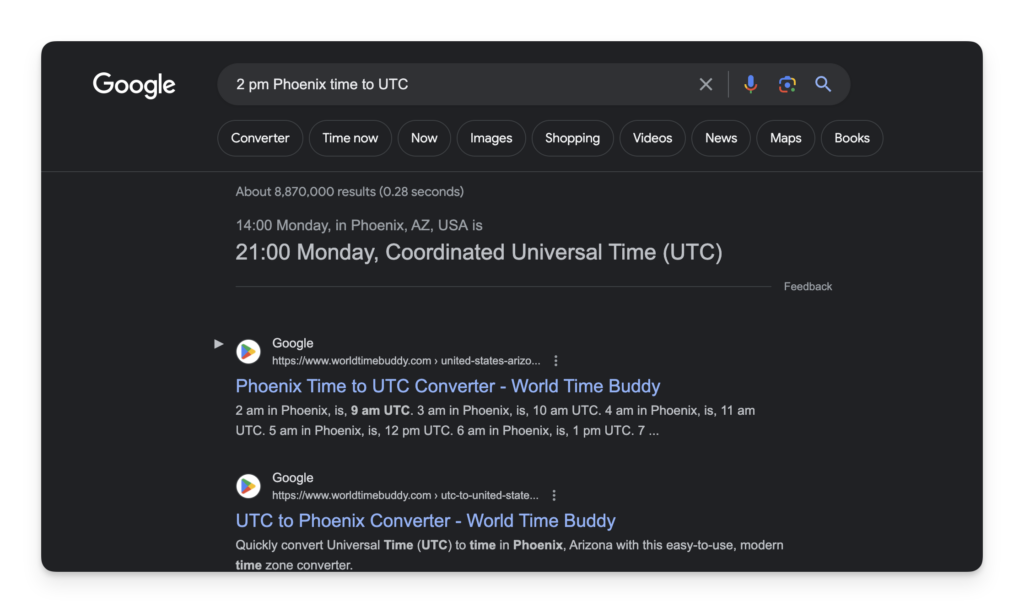One of the best ways to peek behind the curtain of aviation is by listening to conversations between pilots and Air Traffic Control (ATC).
The best part?
Anyone can join in with nothing more than an internet connection. If you’re reading this, you’ve got everything you need already!
But finding ATC transmissions is only part of the challenge. Making sense of what’s being said is even more intimidating.
In this article, we’ll explain, step-by-step, how to find, listen to, and understand ATC transmissions – all without spending a penny.
Key Takeaways
- Listen to ATC for free on LiveATC with just an internet-connected phone or laptop.
- LiveATC is available worldwide, but coverage is limited in some areas.
- Alternatively, use a radio receiver. You will only have access to local ATC transmissions.
- Radio receivers have a learning curve and an upfront financial cost.
- LiveATC offers access to past ATC recordings and has a dedicated mobile app.
Listening to ATC Using a Computer or Phone

Streaming services and apps are second to none when it comes to convenience and ease of use. There’s no fiddling with antennas or manually looking up frequencies – all you need is your device and an internet connection.
Just open the app or website, and you’re there.
The biggest drawback of using an online service is that it leaves you dependent on an internet connection.
You’re also entirely at the mercy of the ATC audio service provider. Apps and websites prioritize airports and regions that have lots of demand from listeners. Smaller and less popular airports are often not included in their coverage.
LiveATC, in particular, relies primarily on volunteers using spare radio equipment, so areas short of hobbyists are out of luck.

As you can see from the map, LiveATC’s coverage across Africa and Asia is somewhat sparse.
There’s also a notable coverage hole over the United Kingdom. In the UK, an outdated 1942 law makes it illegal to stream ATC feeds. While owning a scanner is legal, listening to non-public transmissions requires authorization.
As of November 2023, local laws in certain locations in the world also restricted or blocked streams in Belgium, Germany, Iceland, India, Italy, New Zealand, and Spain.
There aren’t any restrictions on using your own radio scanner, though, and ATC transmissions are not encrypted. They’re open and free for anyone to receive. You may even receive frequencies that LiveATC isn’t streaming for your location.
The downside is that you’d need to spend money to buy a scanner and then learn how to operate it. Radio scanners are also heavily limited by range, only allowing access to tower communications local to you.
You’ll also need to carry the physical device with you wherever you go, whereas the website is available from any place with an internet connection.
LiveATC
Using the LiveATC service is very easy. You don’t need to make an account or subscribe, and you can access the website on any smartphone or computer.
Here’s how.
Step 1
Go to https://www.liveatc.net/ and look for the search box labeled “Airport / ARTCC Code” on the top left.
You’ll need to know the code for the airport you want to listen to.

So, what are airport codes?
Most airports have an identifier code given to them by the International Civil Aviation Organization (ICAO) and the International Air Transport Association (IATA).
IATA codes consist of three letters, such as ORD for O’Hare airport in Chicago.
ICAO codes have four characters and are usually (but not always!) the same as the corresponding IATA codes, with an extra letter in the beginning for the country. In the US, this letter is (almost) always “K”. O’Hare’s ICAO code is KORD, for example.
Okay, back to business.
Enter the ICAO or IATA code for the airport you’re looking for and press the search button. If you don’t know the code for your airport, you can look it up at the FAA’s airport database.

Alternatively, just use the box labeled “Site-wide search” on LiveATC.
During cruise flight, aircraft are in contact with ATC centers that cover large areas. These are known as Air Route Traffic Control Centers (ARTCCs) in the US. If you want to listen to these frequencies, you need an ARTCC code instead. The FAA lists them here.
Step 2
Select the channel that’s streaming the frequency you’re looking for.
This is what the search result for O’Hare looks like. The gray box has the airport information and current weather data. Available frequencies are listed below.

For some stations, the website groups a bunch of frequencies together into one audio stream. You’ll see this in cases where there are either a lot of frequencies at a major airport or LiveATC doesn’t have enough sources available in the area to assign separate frequencies to each one.
Step 3
Press the green ‘Listen’ button to start the audio stream in a new window.


Pressing the play button starts the stream. The sound graph shows if there’s an active transmission.
The frequency is kept clear unless someone needs to talk, so don’t worry if you don’t hear anything for a while. Wait for a bit, or switch to a more active frequency.
Also, consider the current time at the airport you’re listening to. Many airports shut down operations at night.
Channels with engaging content typically draw in more listeners. We recommend checking out the list of the top 50 most popular feeds on LiveATC.

Mobile Apps
LiveATC also offers an app for your iOS or Android device to listen on the go. They don’t require a subscription, just a one-time fee of $4 to purchase the app.
The app is even more straightforward than the website.

There’s no difference in content between the app and the website. You’re free to use the website even on your phone, but it’s a bit harder to navigate through the website on a small screen.
The app offers large buttons and a simplified interface that provides a better experience on mobile devices.
Using the app also allows you to leave the audio running in the background, so you can use other apps or turn the screen off while listening.
Listening to ATC Using a Radio
If you’re only interested in listening to local traffic, a handheld receiver is a viable option. It frees you from being tied down to a reliable internet connection and allows you to operate in areas outside of LiveATC’s coverage.
Expect the range to be limited to roughly 30 miles. You will also need to be within line-of-sight of the ATC tower. This means that buildings, terrain, and weather will block signals, so consider your environment before going this route.
If you live in a mountain range, a radio receiver likely won’t work.
Most handheld scanners operate similarly to a standard AM/FM radio. They are designed to receive, but not transmit, signals.
If you are familiar with using traditional radios, you’ll find many similarities in operating a scanner.
In contrast, a full aviation radio set is called an aviation transceiver since it can transmit and receive signals.
They’re significantly more expensive than simple scanners and require a Restricted Radiotelephone Operator Permit to use legally.
The learning curve for handheld receivers is not as steep as you might expect, but even basic receivers have a hefty upfront cost. Decent handheld receivers start at around $100 to $150.
How to Listen to Past ATC Recordings
Heard something interesting or missed a significant incident?
LiveATC records nearly all frequencies and lets you play them back. You can access recordings by clicking the ATC Audio Archives link in the sidebar on the left side of the home page.

Here’s how you can find a past recording.
Step 1
Set the calendar to the date you want to listen to and pick the time from the dropdown menu.

Keep in mind that the website uses Coordinated Universal Time (UTC), so you’ll have to convert the local time at the station to UTC.
A simple Google search is the easiest way to find UTC time.
Search for “[Local time] [City] time to UTC”.
For example, to convert 2 pm Phoenix time to UTC, search “2 pm Phoenix time to UTC.”

Step 2
Select the feed you’re looking for from the dropdown menu. It’s ordered by ICAO code, so you’ll need to know the designator for your airport.

An alternate way to do this is to search for the airport using the website’s normal search function and open up the airport page.
Every feed listed on the page has its own Archive Access link just above it. Clicking that link brings you to the archive page with the feed already preselected.

LiveATC offers playback for conversations up to a year old for a fee.
How to Find ATC Frequencies
While LiveATC has a list of channels, you’ll need to find the right frequency if you’re using a radio.
You can use the FAA’s own database or other free websites like SkyVector.
First, let’s look at how to use the FAA’s database.
- First, find the ICAO designator for the airport. You can use the FAA’s Airport Facility Directory for this step.

- Next, find the frequency. The FAA’s Aeronautical Information Service (AIS) offers free and comprehensive airport data with a search tool that you can access here.
- Open the search tool, enter the airport designator into the box, and press “Lookup.”

- Scroll down to the communications section to get a list of frequencies available for the airport.
Here’s an example for Prescott Regional Airport (KPRC).

Alternatively, you can use the SkyVector website.
- Look for the search box on the top left of the home page and enter the ICAO designator for your airport. Hit enter.
- The map view will center on the airport. Right-click on the airport and click on the airport’s name.
- Scroll to the Airport Communications section to find the frequencies.

How to Understand ATC Communications
Now that you know how to listen to live ATC conversations, your next challenge is understanding what they’re saying.
Choose an Easier Frequency
Transmissions between controllers and pilots in busy sectors are fast-paced and complex. LiveATC channels with multiple frequencies sometimes have overlapping transmissions. Quieter channels make it easier to keep up with individual aircraft.
If your local airport is small, it might be uncontrolled. At uncontrolled airports, pilots talk to each other on a Common Traffic Advisory Frequency (CTAF). The conversation here tends to be slightly more informal and less complex.
As a beginner, try listening to controlled airports that have relatively low traffic, such as Boeing Field or San Antonio International.
Find Terminology
When you come across an unfamiliar term, look it up on Google. Be careful, though, since the FAA sometimes uses different phraseology and definitions compared to their international counterparts.
For conversations in the US, have a look at the FAA’s Pilot/Controller Glossary to help figure out what they’re saying.
The FAA’s Aeronautical Information Manual (AIM) has a chapter dedicated to Radio Phraseology. It offers guidance on phraseology and standard aviation language. It also explains the phonetic alphabet that pilots and Air Traffic Controllers use.
Use these resources to create a “cheat sheet” of some of the difficult terms until you get used to them.
Using Charts
You can also use charts and maps to add a visual dimension to what you’re hearing.
ATC transmissions frequently reference navigational aids (NAVAIDs), airways, and waypoints that aren’t found in conventional maps.
Use Enroute Charts to look at airways and airspace structures between airports. Terminal Area Charts (TACs) and Instrument Approach Procedure (IAP) Charts can also help you understand approach and departure routes. Airport Diagrams make taxi instructions and airport ground operations understandable.
SkyVector is the easiest way to access this information in the US.
You can also use the FAA’s Information Gateway.
Using Flight Trackers
Live flight trackers such as Flightradar24 or FlightAware show the current position of aircraft on a map. They also label each flight with its callsign. That’s the same callsign you hear on the frequency.
Most flight trackers feature a search box on the home page. Search for an airport, flight number, or aircraft you’re interested in.

Match the aircraft on the map with the instructions ATC gives to each callsign and observe how the aircraft’s flight path reacts to them.
Flight trackers also list aircraft speed, heading, and altitude information. This lets you see altitude adjustments or speed changes.

Like LiveATC, some flight trackers feature historical data, too. You can use this while listening to the audio archive to understand an incident or follow an unusual flight pattern.
Conclusion
Whether you’re a student pilot or simply curious about aircraft, tuning into ATC frequencies provides real-time insights into the operational side of aviation.
One of the most common ATC instructions you’ll hear is related to a “Squawk Code.” If you’d like to learn more, look at our article on Squawk Codes.



